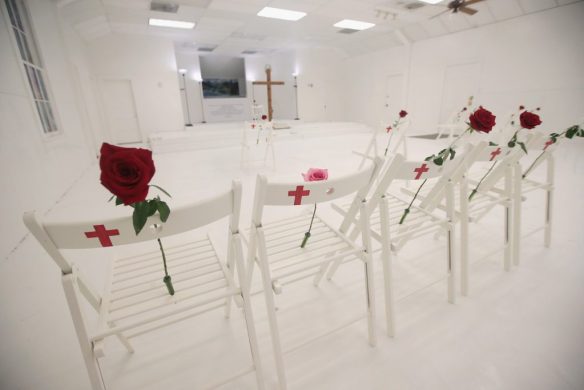 New Orleans The horrific tragedies of our time call for action that is often unheeded, and it has forced me to think more and more about this puzzle. I have increasingly gravitated to a conclusion that part of the mystery of why this happens is that we inadvertently are allowing ourselves to minimize the impact by only focusing on the dead, leaving in silence the many who are permanently maimed, physically and mentally, and by doing so, silencing their voice.
New Orleans The horrific tragedies of our time call for action that is often unheeded, and it has forced me to think more and more about this puzzle. I have increasingly gravitated to a conclusion that part of the mystery of why this happens is that we inadvertently are allowing ourselves to minimize the impact by only focusing on the dead, leaving in silence the many who are permanently maimed, physically and mentally, and by doing so, silencing their voice.
I was struck by the power of the memorial created by the pastor and congregants of the First Baptist Church in Sutherland Springs, Texas after the tragic shooting in their church recently. They made the church itself a memorial with twenty-six white chairs sitting in the church to symbolize their members that lost their lives in the massacre. The dead deserve such a fitting remembrance. To lose life is the loss of everything and the ultimate and permanent tragedy, so let there be no misunderstanding on this score.
But, I couldn’t help thinking about how easy it would have been for them to place another twenty chairs in this space they shared, even if separately, to acknowledge those that were wounded as well. The pain of the experience is also something they will bear for the rest of their lives. Some may heal physically, but the scars of that morning will be etched on both their bodies and minds for the rest of their days.
The shooting at the concert in Las Vegas was, if anything, even more terrible, if decidedly less personal. Fifty-eight people were killed. Lists of other mass shootings rank Vegas as very high in US history. That figure will be repeated forever, but there were four hundred eight-nine people wounded, many of whom will physically be maimed for life. Fifty-eight dead is unimaginable, but 489 is beyond any comprehension. Is their pain not equally worthy of attention? In the events of 9/11, a watershed moment in US history, 2996 were killed, but 6000 were injured both at the World Trade Center in New York City and the Pentagon in Washington.
It’s not just gun violence or terrorism, but even highway safety where we are allowed to gloss over the full dimensions of tragedy and silence the demands for change by minimizing the violent impacts. The latest figures from 2015, the National Safety Council counted 38,300 dead, a figure so large that it is past our realistic human ability to internalize, yet how do we absorb the fact that 4.4 million were injured in car crashes, if we even hear or read the figure at all. Globally, 1.3 million die in road crashes – I can’t even call them accidents at this point which would dilute their power even more – and they only estimate the number of injuries at 20 to 50 million, because the fact that many countries are not counting indicates how little we have come to care.
No matter whether we agree on the need to deal with gun and traffic safety or even the steps that guard national security, as a culture we need to come to grips not only with the dead, but also the wounded and injured. We have allowed the dead and their tragedy to become hallowed, because they have no voice and can be revered for their sacrifice and in some ways their silence, and in so doing we have reduced the full dimensions of these tragedies by ignoring those hurt and maimed. In dealing with these issues as a society, we need to recognize the price they continue to pay and allow their voices to be heard more clearly and loudly in the debates over future action.